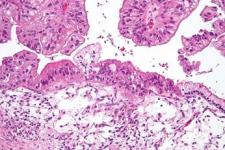Should We Sequence the DNA of Every Cancer Patient?
By Antonio Regalado,
MIT Technology Review
| 06. 14. 2016
A startup called Strata Oncology says it plans to give away advanced genetic tests to 100,000 patients struggling with cancer. But there's a profit motive: it hopes to identify patients with specific rare DNA errors and steer them to drug companies.
Strata, which was founded last year and has raised $12 million from investors, says it is set up to run 50,000 next-generation sequencing tests a year. Such tests probe the DNA of tumor tissue, searching for mutations in hundreds of genes at once, hoping to surface clues about what drug a patient should be taking.
Similar tests are already offered commercially to doctors by several companies, including Foundation Medicine of Cambridge, Massachusetts, and can cost $5,000 each.
Continue reading on MIT Technology Review
Image via Wikipedia
Related Articles
By Megan Molteni and Anil Oza, STAT | 10.07.2025
For two years, a panel of scientific experts, clinicians, and patient advocates had been hammering out ways to increase community engagement in National Institutes of Health-funded science. When they presented their road map to the NIH Director Jay Bhattacharya last...
Paula Amato & Shoukhrat Mitalipov
[OHSU News/Christine Torres Hicks]
On September 30th, a team of 21 scientists from Oregon Health & Science University (OHSU) published a significant paper in Nature Communications, with a scientifically accurate but, to many, somewhat abstruse headline:
Induction of experimental cell division to generate cells with reduced chromosome ploidy
The lead authors were Shoukhrat Mitalipov, recently described here as “a push-the-envelope biologist,” and his long-term colleague Paula Amato. (Recall that in July the pair had co-published with...
By Pam Belluck, The New York Times | 10.17.2025
Before dawn on a March morning, Doug Whitney walked into a medical center 2,000 miles from home, about to transform from a mild-mannered, bespectacled retiree into a superhuman research subject.
First, a doctor inserted a needle into his back to...
By Julia Black, MIT Technology Review | 10.16.2025
Consider, if you will, the translucent blob in the eye of a microscope: a human blastocyst, the biological specimen that emerges just five days or so after a fateful encounter between egg and sperm. This bundle of cells, about the size of...




